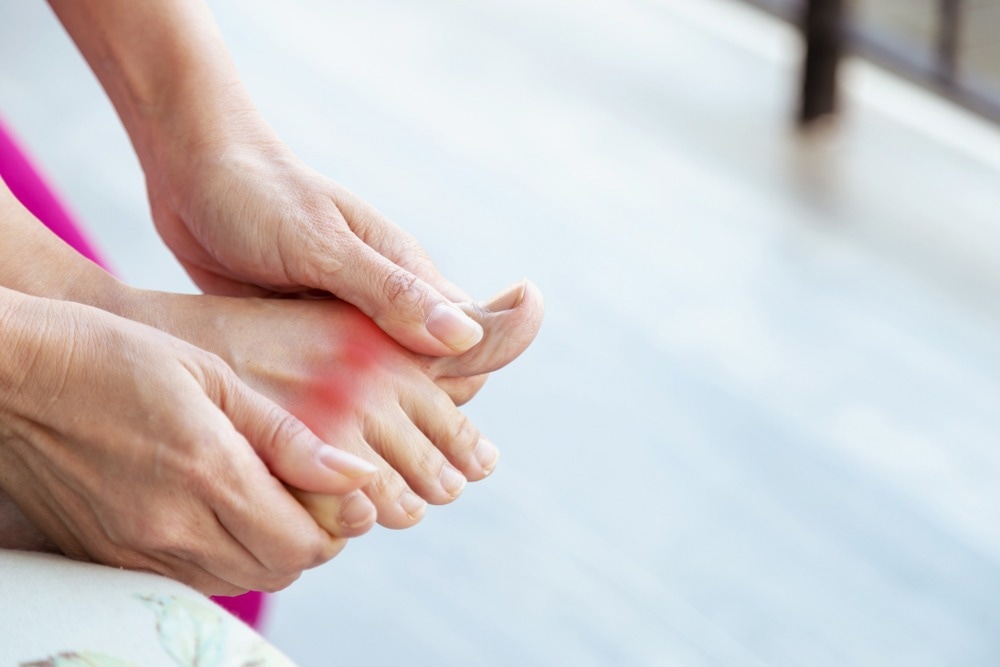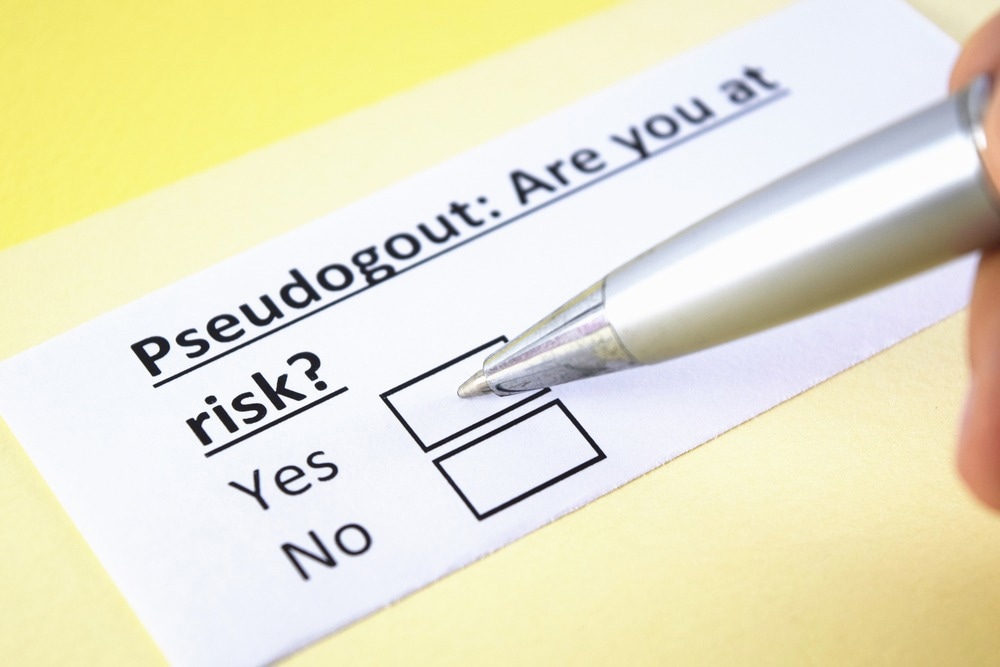What is gout?
Is pseudogout the same as gout?
What causes pseudogout?
What are the symptoms of pseudogout?
How is pseudogout diagnosed?
What are the risk factors for pseudogout?
What are the treatments for pseudogout?
Summary
References
Further reading
Pseudogout, also called calcium pyrophosphate deposition (CPPD), is a form of arthritis that commonly affects the knees. It is characterized by the sudden and painful onset of swelling in one or more joints and is similar to gout. Symptoms can occur very quickly, sometimes over a few hours, and remain for approximately three to 10 days.

Image Credit: sumroeng chinnapan/Shutterstock.com
What is gout?
Gout is a condition that more commonly affects men and can sometimes run in families. It is caused by small crystals forming in and around the joint due to an accumulation of uric acid in the blood.
Uric acid is a waste product that is created when the body breaks down purines, chemicals that are present in the nuclei of plant and animal cells. In humans, purines are categorized as endogenous purines, which are made by the body, and exogenous purines, which enter the body through food. As such, foods that are high in purines (such as alcohol, meat, and shellfish) should be avoided if a person has gout to limit the amount of uric acid the body produces.
Is pseudogout the same as gout?
Pseudogout is so named because of its clinical similarity to gout. However, pseudogout is caused by a different kind of crystal called calcium pyrophosphate crystals. Additionally, it is not connected with diet or alcohol consumption, as is the case with gout.

What causes pseudogout?
It is not clear why the calcium pyrophosphate crystals form, and not everyone who develops crystals in their joints will experience pain or swelling. Painful ‘attacks’ of pseudogout may be due to the release of calcium pyrophosphate crystals into the joint fluid, attracting white blood cells.
A mutant ANKH gene located in chromosome 5 has been studied for its link to familial cases of pseudogout. The ANKH gene is responsible for encoding a transmembrane transport protein that generates extracellular inorganic phosphate, which facilitates the growth of pseudogout crystals.
Accumulation of iron in the joints has also been identified as a possible contributor to pseudogout development from reports of the condition in patients with iron overload from transfusion hemosiderosis and hemophilia.
What are the symptoms of pseudogout?
Pseudogout onset is characterized by hot, red, and swollen joints that are painful to move. Symptoms will usually develop suddenly. Although gout can produce tophi, white bumps under the skin caused by the crystals themselves, bumps caused by pseudogout crystals can usually only be seen by X-ray.
How is pseudogout diagnosed?
To diagnose pseudogout, the doctor must be able to rule out other conditions, such as gout, rheumatoid arthritis, and joint infections. A discussion of the patient’s symptoms will begin the diagnosis. Blood tests, tests of the joint fluid, and imaging of the joint itself (ultrasound, X-ray, CT, or MRI scan) will show whether calcium pyrophosphate crystals are present in the joint.
What are the risk factors for pseudogout?
Increasing age is thought to be the main risk factor for pseudogout. Approximately 3% of people in their 60s and 50% of people in their 90s will be affected by calcium pyrophosphate crystals.

Image Credit: Yeexin Richelle/Shutterstock.com
A history of injury to the affected joint or a family history of the condition can also contribute to a person’s risk of developing pseudogout. It can occur after a person has had pneumonia, a heart attack, stroke, or surgery. Pseudogout has also been seen in people with thyroid problems, with high levels of calcium and iron, and in people with problems with the parathyroid glands.
What are the treatments for pseudogout?
There are no treatments available for eradicating crystals in the joints. Nonsteroidal anti-inflammatory drugs (NSAIDs) are commonly prescribed to ease pain and swelling in acute attacks.
For patients who cannot take NSAIDs, such as those with impaired kidney function, a history of stomach ulcers, or patients who are taking blood thinners, the joint fluid may be drained. Corticosteroids may be injected into the joint instead of using NSAIDs to treat pain and swelling.
In rare and severe cases of pseudogout, surgery can be carried out to repair or replace joints damaged by the condition.
Studies have shown that transmembrane-transport inhibitors have reduced the production of extracellular inorganic phosphate in vitro, but there has been no evidence of the same effect occurring in humans. Treatments that directly target transmembrane transport and treatments that directly target calcification in the joints may have the potential to treat pseudogout.
Additionally, an interleukin 1 beta antagonist has been used to reduce inflammation.
Summary
Pseudogout is clinically similar to gout with respect to symptoms. However, the types of crystals that form in the joints in pseudogout are different from those seen in gout. The risk of developing pseudogout increases with age, and it is thought that incidence rates of pseudogout will increase with an increasingly aging population. Treatments generally focus on symptom management over disease eradication, as it is currently not possible to remove pseudogout crystals from the joints.
References
Further Reading
Last Updated: Nov 3, 2022